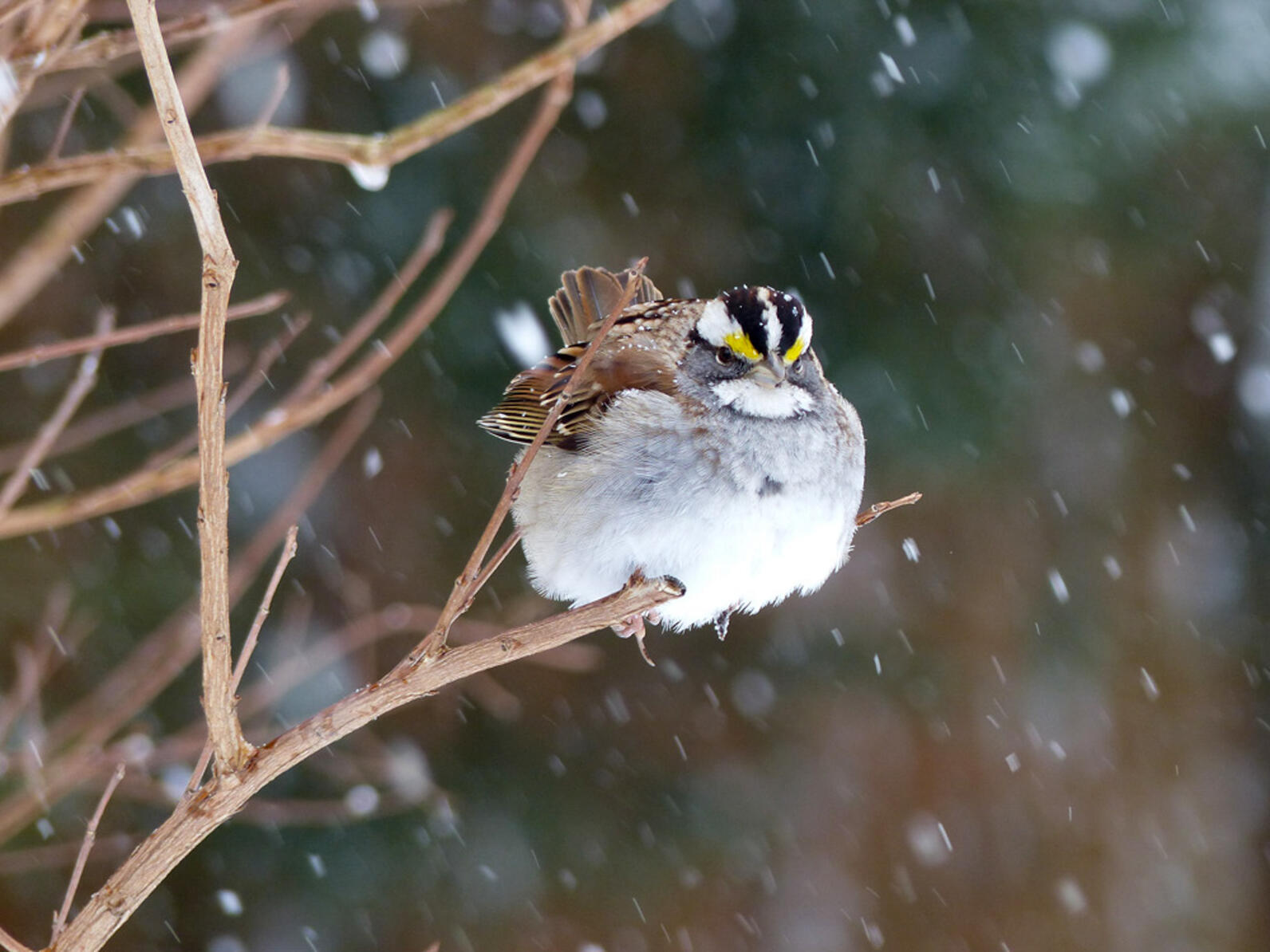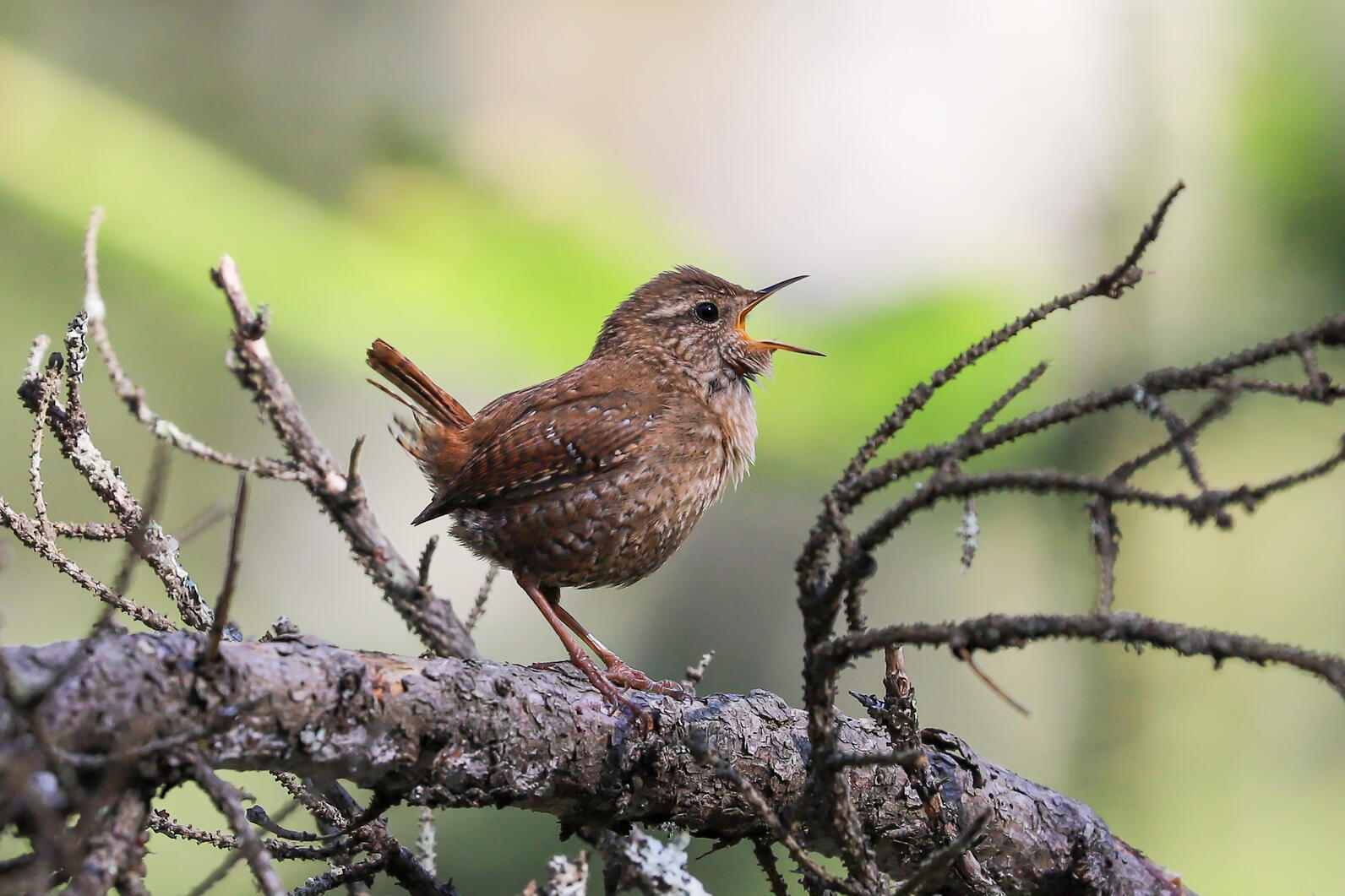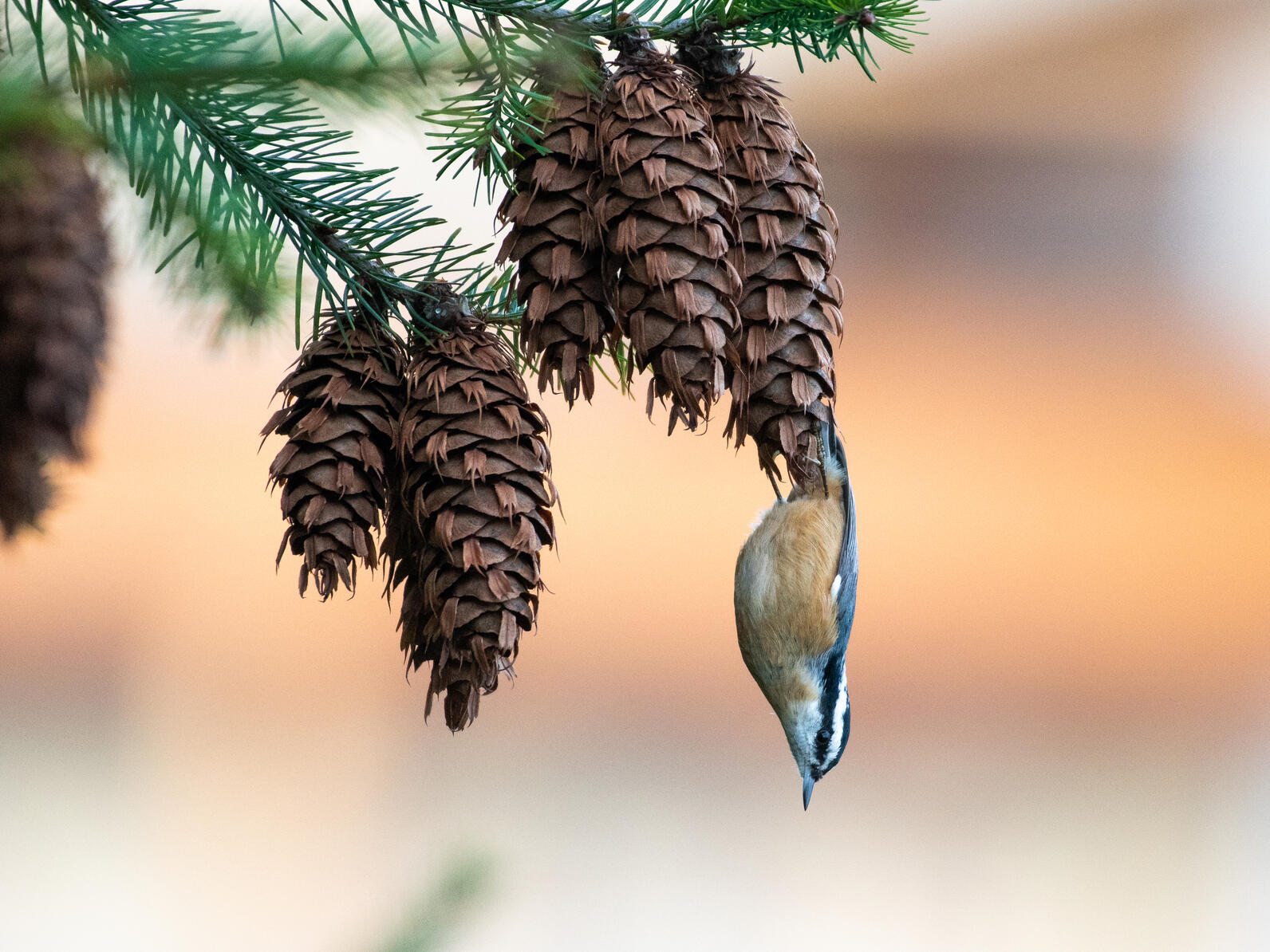With winter comes frosty mornings, crisp air, and a different cast of birds that have settled in our state from farther north, even as far as Canada and Alaska. If you’re new to birding, or just want to know what to look out for this winter, this guide is for you.
From the mountains to the coast, here are some winter residents that you can see right in your backyard.
Cedar Waxwings are found along the North Carolina mountains year-round but will overwinter throughout the state. In fact, dozens or even hundreds will suddenly appear in an area, often to feast on winter berries. They spend most of the year in flocks—a testament to their social nature.
A relatively small bird, waxwings are brown with a black mask and pale-yellow belly. They have yellow tips on the tail feathers and hard, red, wax-like tips on the secondary wing feathers. Their most recognizable call is a thin lisp, tseee sound.
The Hermit Thrush is a fairly common winter resident in North Carolina, coming from Canada and places farther north, although they also be found breeding in spruce fir forests of western North Carolina during the spring and summer. Throughout the winter, they mostly feed on berries and insects and can be found hopping around in your backyard leaf litter looking for their next meal.
This thrush is olive-brown above with a reddish tail that bobs up and down. The tail bob is different than other tail-bobbers like phoebes; Hermit Thrush pull their tail up and then drop it slowly, often accompanied by their call note. They have a gray-brown face with a whitish eye ring. It is white below with large spots on the breast that form narrow streaks on the sides of the throat and flanks. They make a low tuck call.

A common sparrow that can be spotted at your backyard bird feeder or more shrubby areas in the winter is the White-throated Sparrow. They spend the breeding season across most of Canada and far northern corners of the U.S., only coming south during the colder months. These sparrows eat mostly insects and seeds.
They have two color forms: one with black and white head stripes, the other with dark brown and tan head stripes. Both have a sharply defined white throat patch and a dark bill. Their song is a clear whistle: Poor Sam Peabody, Peabody, Peabody, or Sweet Sweet Canada, Canada, Canada.
Another sparrow to be on the lookout for this winter is the Fox Sparrow. There are different subspecies of Fox Sparrow but in the east, they are rich rufous-and-gray with heavy streaking of the under parts, have a slightly notched rust-colored tail and a rounded head.
They spend most of their summer in the northern parts of Canada up toward Alaska migrating to the southeast U.S. for the winter. They are especially loud birds and can be seen scratching through the leaves for insects. They have a lively song that opens with a clear whistle followed by short trills or churrs. Its call is a sharp chink.

There’s no guarantee that these small finches will show up in North Carolina, but keep an eye out for the Pine Siskin at your backyard feeder. They usually find solace in the hemlocks, birches, and cedars of boreal forests up north but also nest sparingly in the high mountains of western North Carolina. In winter they sometimes travel in large flocks southward, in search of seeds.
The smallest winter finch, Pine Siskins are streaked with brown with yellow patches along the base of the flight feathers and tail. They have a thin, pointed bill and make a distinctive rising bzzzzzt sound.
The Rusty Blackbird is known for its love of water, wintering around swamps, riversides, and lakes. This blackbird breeds in the boreal bogs of Canada and Alaska as well as northern New York and New England, coming to the southeastern U.S. for the winter. These blackbirds have undergone a steep population decline beginning in the second half of the 20th century. It’s not clear what is causing these declines but habitat destruction is likely a leading factor.
In fall, Rusty Blackbirds are rust-brown, especially on the head, breast, and back and have bright pale-yellow eyes. They have a squeaky voice, almost sounding like a rusty gate. Its call note is a sharp check.
The Yellow-rumped Warbler is a common winter warbler in North America, although some migrate to the tropics in the fall. They are also a common sighting in North Carolina during the winter, coming from Canada, parts of Alaska, and the northern U.S. Yellow-rumped Warblers winter further north than any other warbler, partially because of their larger size and ability to digest waxes found in wax myrtle and bayberries.
If you have native plants in your yard, you’re sure to attract a few as their diet mainly consists of berries and insects. The Eastern (“Myrtle Warbler”) subspecies has a white throat and two white wing bars. In fall they are streaked gray-brown with white spots on the tail and a yellow rump, which is why they’re affectionately known as “butterbutts.”

Known for their sweet song that can pierce through cold winter days, Winter Wrens spend most of the year in the mountains of western North Carolina and places further north, but can be found across the state during the winter. They’re a secretive bird that can be found in dense woody areas, often creeping along the ground looking for insects.
They are small, plump, and brown overall with darker brown bars on the tail, wings, and belly. Their tail usually sits straight up, giving them a distinctive appearance. They have a high-pitched voice and a kimp-kimp or kit-kit call note.
Perhaps the best-named woodpecker around, the Yellow-bellied Sapsucker is a common winter resident in North Carolina, coming from our state’s mountains, much of the Northeast, and Canada. They can be found along woodlands and in yards and neighborhoods in winter, clinging to a tree eating sap, insects, or fruit.
They have black and white bodies with a long white stripe along the folded wing and whitish underparts. Both males and females have a bright red forehead, and males also have red throats. They’re pretty quiet in the winter but make cat-like mewing and whining notes.
Dark-eyed Juncos mainly eat seeds and insects so you’ll likely see juncos kicking up leaf litter, scurrying about your garden looking for food, or at your bird feeder. Leaving your leaves where they fall and planting native plants is a great way to attract insects and birds like this junco to your yard.
This gray and white junco is common in North Carolina during the winter, feeding on the ground around woodland edges and suburban yards. Lovingly known as “snow birds” these are a familiar favorite in North Carolina. Their song is a loud trill but can be heard using a tsick or tchet call when in a group.
Juncos nest in the western part of the state, above 3000 feet. A close look at your winter feeder birds reveals two subspecies, the Appalachian form which nests in western North Carolina and has a gray beak and then a northern form with a flesh-colored or pinkish beak. They are easy to distinguish at feeders, and the northern form outnumbers the local breeding population in most parts of the state in the winter. Most mountain birds stay fairly close to the mountains during winter, moving up and down in elevation in response to bad weather.

Red-breasted Nuthatches prefer the spruce, fir, and hemlock conifer forests of the Northern U.S., Canada, and western North Carolina but may migrate hundreds of miles south in winter to find food. During the cold months, they can be seen in wooded areas looking for insects and especially seeds.
These nuthatches are blue-gray with boldly patterned heads featuring a black cap and stripe through the eye, broken by a white stripe above the eye. Their underparts are a rusty-red color.
Have you caught a glimpse of your favorite winter resident? We want to hear from you! Tell us about it on Facebook, download the Audubon Bird Guide App, and plan your trip with the NC Birding Trail.









